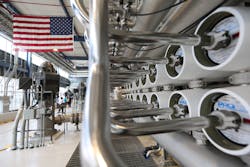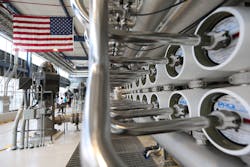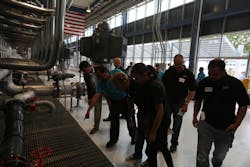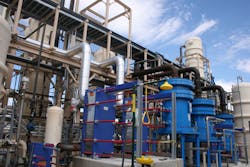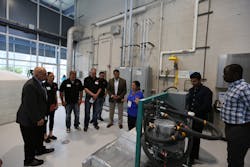VIDEO: Texas desalination plant marks 10 years of innovation
The Kay Bailey Hutchison Desalination Plant has evolved into an industry model, attracting visitors from around the globe.
EL PASO, TEXAS, OCT 6, 2017 -- Employees, legislators and industry experts gathered Sept. 15 to celebrate the 10th anniversary of the Kay Bailey Hutchinson Desalination Plant. A centerpiece of the day was a research forum, featuring highlights of experimental work conducted at the in-house laboratory and how the findings could shape the future of desalination.
Celebrating sustainability
"Given the vast brackish groundwater resources, desalination has become an important part of the puzzle that will ensure we have a vital water future for this community, including for our kids, grandchildren and anybody that wants to live here in the future," said John Balliew, president and CEO of El Paso Water.
When Ed Archuleta first came to the utility in the late 1980s, El Paso was facing a bleak future in water management – including predictions the city would run out of water by 2009.
Archuleta, former president and CEO of the utility, spoke about the challenges El Paso faced when he first arrived.
"How can you have economic development if people don't have water," he said. "Water means public health, water means security, but it also means economic development. This city was trying to find ways to provide economic development, but we had this issue that we were known as the city that might run out of water."
Since opening in 2007, the groundbreaking KBH Desalination Plant has produced 17 billion gallons of water and played a pivotal role in building up El Paso's resiliency to droughts while meeting the water needs of a growing population. "The plant is a unique asset to this community that sets El Paso apart; it is a part of the story of the innovation here in El Paso," Mayor Dee Margo said.
"This stands as a great example to the rest of the arid west and is an essential component of El Paso's portfolio of water resources to help sustain the thriving local economy and the military operations at Fort Bliss," said Guy Carpenter, president of the national WateReuse Association.
The KBH Desalination Plant has also become a model, attracting visitors from around the globe, including from as far away as Brazil, Israel China, Iraq and Sudan. Many of these countries are also facing more frequent droughts and other serious water supply challenges.
Water plant Senior Technician Jose Ronquillo (second from left) shows feed water piping that feeds the reverse osmosis booster pumps at the KBH Desalination Plant.
EWM partnership on concentrate management
The day's events featured tours of the desalination plant and the new neighboring facility operated by Enviro Water Minerals that will take the plant's brine concentrate – which would otherwise go through a deep well injection process – and turn the salts and minerals into industrial-grade commercial products.
EWM calls it the first full-recovery desalination facility. As part of a utility partnership, EWM will then sell fresh drinking water back to the utility. At full capacity, EWM has the ability to produce 2 million gallons per day.
By changing how El Paso Water manages concentrate, the EWM partnership may help position the utility to expand the desalination plant. The biggest barrier to expansion, so far, has been concentrate management.
Enviro Water Minerals' concentration system processes the diluted chemicals manufactured in the plant. They are then concentrated to commercial strengths.
Research forum looks to the future
Central to the day was a research forum, in which water industry experts provided an outlook for desalination and described obstacles.
Researchers from a number of regional universities also convened to share results of work either underway or completed at the Consortium for Hi-Technology Investigations in Water & Wastewater (CHIWAWA) research laboratory, which is housed inside the desalination plant.
Paul Choules, president of the Texas Desalination Association, spoke about taking advantage of the lower costs of energy in Texas. The Texas Coalition for Affordable Power released a report this summer on the declining costs of energy in Texas and credited a competitive market; use of wind, solar and nuclear power; and the price of natural gas as major reasons.
"The reality is in the state of Texas we should be able to desalinate cheaper than anywhere in the world, and one of the major reasons for that is the cost of energy," Choules said.
Carpenter said that for inland desalination applications, brine management is the chief barrier nationwide. He said utilities will continue to contend with the expensive options for removal, such as evaporation, thermal brine concentration and deep well injection.
Lucy Mar Camacho, (center) an assistant professor in environmental engineering at Texas A & M University-Kingsville, explains her research in advances in membrane distillation for water desalination to visitors at the KBH Desalination Plant.
Barbara Martin, director of engineering and Technical Services for the American Water Works Association, noted there are a few technical barriers that need to be overcome before more widespread use of desalination can be adopted in the industry.
Martin said she was pleased to learn that many researchers, particularly through the CHIWAWA lab and in the EWM project, are working on the challenges of residuals management and concentrate disposal.
She also commended researchers who were tackling how best to improve membrane treatment. Research presentations delved into self-cleaning filters, microfiber cartridges, and electrodialysis among options to improve the membrane filtration process.
Martin also acknowledged that another pending barrier is that of a skilled workforce with many retirements expected in the coming year across the utility sector.
"The great thing is EPWater and others in the field are pushing the envelope and doing that research and finding solutions, so that we can provide a blueprint for utilities to follow and hopefully increase the use of desalination technology in the future," she said.
"The research underway here will shape the future of desalination for the nation," Archuleta said.
